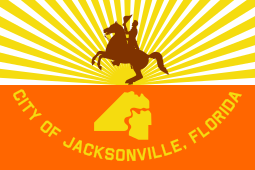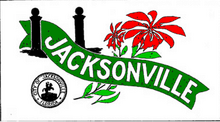
The flags of the U.S. states, territories, and the District of Columbia exhibit a variety of regional influences and local histories, as well as different styles and design principles. Modern U.S. state flags date from the turn of the 20th century, when states considered distinctive symbols for the 1893 World's Columbian Exposition in Chicago, Illinois. Most U.S. state flags were designed and adopted between 1893 and World War I.

The flag of Indianapolis has a dark blue field with a white five-pointed star pointing upwards in the center. Around the star is a circular field in red. Surrounding the red field is a white ring, from which extend four white stripes from top to bottom and from hoist to fly, thus creating four equal quadrants in the field. The stripes are about one-seventh the width of the flag, with the white ring the same width as the stripes. The diameter of the red circle is about two-ninths the width of the flag.
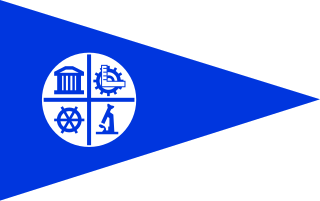
The flag of Minneapolis is the official municipal flag of Minneapolis, Minnesota.

The city flag of Los Angeles consists of a background of three notched stripes of green, gold and red. The flag was designed by Roy E. Silent and E.S. Jones in 1931 for the Los Angeles sesquicentennial from 1781.

The city flag of Portland, Oregon, consists of a green field on which is placed a white four-pointed star from which radiate blue stripes, each bordered by L-shaped yellow elements. Narrow white fimbriations separate the blue and yellow elements from each other and from the green background. The official ordinance specifies a height of 3 feet and a length of 5 feet.

The flag of Birmingham was designed by Idyl King Sorsby for the occasion of the semicentennial of the city of Birmingham, Alabama in 1921. The flag was officially adopted as the city's flag on August 18, 1925.

The flag of Denver is the official flag of the City and County of Denver in Colorado. It was designed by a North High School student, Margaret Overbeck, and adopted in 1926. A zigzag white stripe horizontally separates a red field below from a blue field above, in which is centered a yellow circle, together forming a stylized depiction of the Sun in a blue sky above snow-capped mountains. The color yellow symbolizes gold in the state's hills, and red the colored earth to which the word colorado refers. The circle's centered position symbolizes Denver's central location within the state. The white zigzag symbolizes Colorado's Native American heritage.
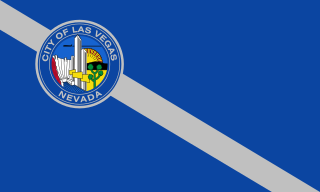
The flag of Las Vegas, consists of blue field with a diagonal gray stripe running from the top of the hoist to the bottom of the fly. Las Vegas' city seal, adopted in 1966, is located in the canton breaking the stripe.
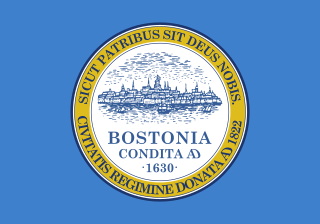
The flag of Boston consists of a sky blue field and the seal of the city of Boston, Massachusetts, United States, in the center. The flag is sometimes flown in a darker shade of blue, more of a turquoise. It was designed in 1913 and adopted by the Boston City Council on January 29, 1917.

The current flag of Billings, Montana, United States, is a "Canadian-like" triband of very dark blue and white with the city seal on the central white panel. The seal shows the Billings skyline line-drawn in blue, with a red disc representing the sun. The seal is outlined in blue with the text "Star of the Big Sky Country" in red capitals. It was designed by Fernando Méndez and adopted in June 1986.
The flag of Richmond, Virginia, was adopted in 1993. The flag contains a navy blue field in the upper two-thirds quadrant with two red and two white stripes beneath in the lower third of the flag. It features a silhouette of a person working a James River bateau down the James River.

The official flag of Mobile is a flag which represents the seal of the six flags that have flown over the state of Alabama before and since it became a state. The flag was adopted in December 1968 after one was suggested by Commissioner Lambert C. Mims. The original seal which was used in the flag was adopted in 1961.

The flag of Fort Wayne, Indiana, was adopted as the city's official flag by City Council on June 26, 1934. The pall design includes two diagonal white stripes converging in the circular center to form a horizontal white stripe. Red silhouettes of a Miami Native American head, a French fleur-de-lis, and a British lion grace a navy blue field. A red blockhouse is located at the center of the converging stripes, with the settlement's founding date and city name.

The flag of Provo, Utah, is the official flag of the city of Provo, Utah, United States. The present flag, featuring the city's logo on a light blue field, was adopted on January 6, 2015, after a multi-year debate to replace a previous one. The former flag, adopted in 1989, was ridiculed in particular for its perceived ugliness and its similarity to the Centrum logo, and was voted one of the worst American city flags by the North American Vexillological Association (NAVA).

The flag of Sioux Falls, South Dakota, consists of a zigzag pattern of thin white and blue lines, which divides an upper blue portion and a lower pinkish-red portion, and a yellow sun in the upper left corner. The zigzag represents the namesake falls of the Big Sioux River. The blue color and the sun allude to the flag of South Dakota. The pinkish-red portion represents the Sioux Quartzite nearby. The upward direction of the design represents the growth of Sioux Falls. The red, white and blue colors included in the flag are also a reference to the flag of the United States while maintaining city and state pride.

The flag of Spokane, Washington, is the official municipal flag of Spokane, Washington, United States. Its design comprises a sun in the canton on a white-and-green field separated by a stylized blue river. The flag was adopted in 2021 and is the fourth to be used by the city government.

The flag of San Antonio is the official municipal flag of San Antonio, Texas. The sketch of the flag's design, drawn by Spanish–American War veteran William W. Herring, was dated May 28, 1933. The design saw significantly more usage than the official flag, but was never officially adopted until 1976. The current flag is a slightly modified version of Herring's design, most notably removing the text formerly displayed.

The flag of Saint Paul is the official municipal flag of Saint Paul, Minnesota. Adopted via a 1932 competition, the current flag is a yellow-blue-yellow horizontal triband. A red shield depicting various aspects of St. Paul's industry and history is in the foreground and a red ribbon reading "SAINT PAUL" in yellow font below the shield.

The flag of Anchorage, Alaska, was adopted by the city of Anchorage in 1973. It is a field of yellow with the seal of the city, which features a blue anchor in the foreground as well as a blue airplane, yellow sun, and yellow sailboat in the background. The words "ANCHORAGE ALASKA" are also present.
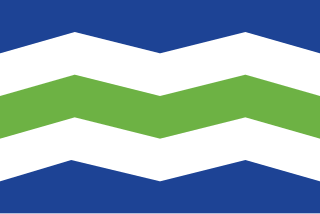
The flag of Burlington, Vermont was adopted by the Burlington city council on November 27, 2017 during the mayorship of Miro Weinberger. It is five horizontal, zig-zag stripes of blue, white, green, white, and blue.
